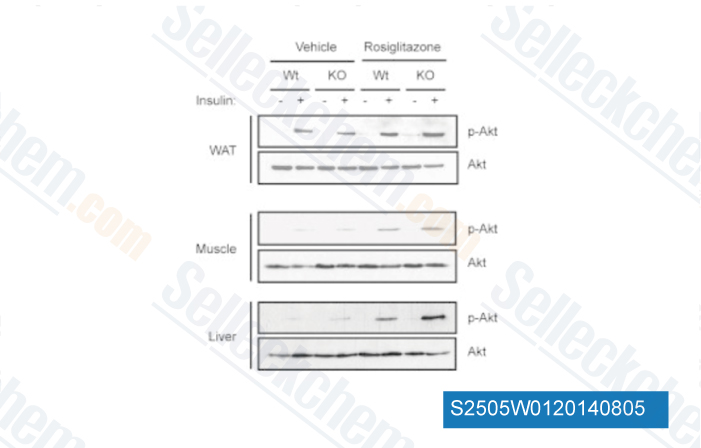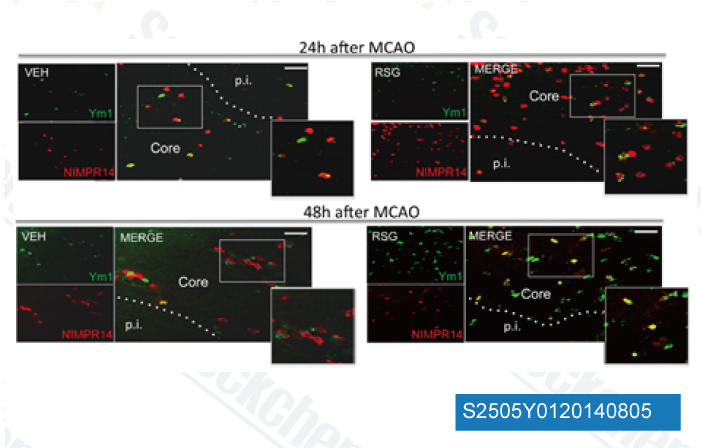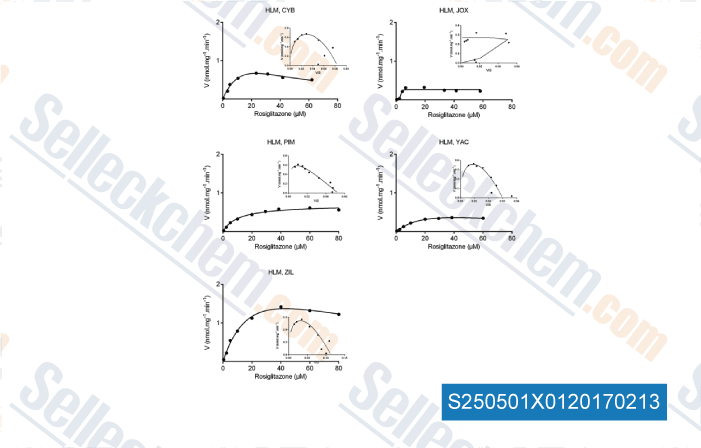|
Toll Free: (877) 796-6397 -- USA and Canada only -- |
Fax: +1-832-582-8590 Orders: +1-832-582-8158 |
Tech Support: +1-832-582-8158 Ext:3 Please provide your Order Number in the email. |
Technical Data
| Formula | C18H19N3O3S.C4H4O4 |
|||
| Molecular Weight | 473.5 | CAS No. | 155141-29-0 | |
| Solubility (25°C)* | In vitro | DMSO | 95 mg/mL (200.63 mM) | |
| Ethanol | 2 mg/mL (4.22 mM) | |||
| Water | Insoluble | |||
|
* <1 mg/ml means slightly soluble or insoluble. * Please note that Selleck tests the solubility of all compounds in-house, and the actual solubility may differ slightly from published values. This is normal and is due to slight batch-to-batch variations. * Room temperature shipping (Stability testing shows this product can be shipped without any cooling measures.) |
||||
Preparing Stock Solutions
Biological Activity
| Description | Rosiglitazone maleate, a member of the thiazolidinedione class of antihyperglycaemic agents, is a high-affinity selective agonist of the peroxisome proliferator-activated receptor-γ (PPAR-γ) with IC50 of 42 nM. Rosiglitazone maleate also modulates TRP channels and induces autophagy. Rosiglitazone prevents ferroptosis. | ||||
|---|---|---|---|---|---|
| Targets |
|
||||
| In vitro | Rosiglitazone is an insulin-sensitising agent of the thiazolidinedione class of oral antihyperglycaemic drugs. Rosiglitazone exhibits insulin-sensitising activity 60- to 200-fold higher than that of troglitazone, englitazone, or piogliazone in rodent models of insulin ressitance. Rosiglitazone reduces hyperglycaemia by improving insulin sensitivity in adipose tissue, the liver and skeletal muscle tissue. Such insulin sensitisation may be partly attributable to the effects of Rosiglitazone on the expression of molecules involved in the insulin signalling cascade. In adipose tissue, Rosiglitazone-mediated PPARγ stimulation promotes adipocyte differentiation. Rosiglitazone may also promote the uptake of free fatty acids in adipose tissue, thus reducing systemic free fatty acid levels. The insulin sensitivity of the liver and peripheral tissues may be modulated indirectly by Rosiglitazone-mediated changes in levels of fatty acid or adipocyte-derived factors, such as adiponectin and TNFα. Rosiglitazone may also be involved in modulating the expression of adiponectin receptors in some tissues, which may be relevant to some aspects of insulin sensitisation. [1] |
Protocol (from reference)
References
|
Customer Product Validation

-
Data from [Mol Metab, 2013, 2(3), 215-26]

-
Data from [Stroke, 2013, 44(12), 3498-508]

-
, , Reprod Toxicol, 2016, 61:162-8
Selleck's Rosiglitazone maleate has been cited by 26 publications
| Generation of functionally competent hepatic stellate cells from human stem cells to model liver fibrosis in vitro [ Stem Cell Reports, 2022, 17(11):2531-2547] | PubMed: 36270282 |
| Elaiophylin reduces body weight and lowers glucose levels in obese mice by activating AMPK [ Cell Death Dis, 2021, 12(11):972] | PubMed: 34671010 |
| Oxygen-sensitivity and Pulmonary Selectivity of Vasodilators as Potential Drugs for Pulmonary Hypertension [ Antioxidants (Basel), 2021, 10(2)155] | PubMed: 33494520 |
| Low-intensity pulsed ultrasound prevents angiotensin II-induced aortic smooth muscle cell phenotypic switch via hampering miR-17-5p and enhancing PPAR-γ [ Eur J Pharmacol, 2021, 911:174509] | PubMed: 34547245 |
| Traditional Chinese Medication Qiliqiangxin Attenuates Diabetic Cardiomyopathy via Activating PPARγ [ Front Cardiovasc Med, 2021, 8:698056] | PubMed: 34336956 |
| Inhibition of the activation of γδT17 cells through PPARγ-PTEN/Akt/GSK3β/NFAT pathway contributes to the anti-colitis effect of madecassic acid [ Cell Death Dis, 2020, 11(9):752] | PubMed: 32929062 |
| Peroxisome proliferator-activated receptor γ (PPARγ) suppresses the proliferation and metastasis of patients with urothelial carcinoma after renal transplantation by inhibiting LEF1/β-catenin signaling [ Bioengineered, 2020, 11(1):1350-1367] | PubMed: 33289586 |
| Inhibition of ACSL4 attenuates ferroptotic damage after pulmonary ischemia-reperfusion [ FASEB J, 2020, 10.1096/fj.202001758R] | PubMed: 33070393 |
| TRIM27-mediated ubiquitination of PPARγ promotes glutamate-induced cell apoptosis and inflammation [ Exp Cell Res, 2020, S0014-4827(20)30690-X] | PubMed: 33385414 |
| Upregulation of FABP7 inhibits acute kidney injury-induced TCMK-1 cell apoptosis via activating the PPAR gamma signalling pathway [ Mol Omics, 2020, 16(6):533-542] | PubMed: 33315023 |
RETURN POLICY
Selleck Chemical’s Unconditional Return Policy ensures a smooth online shopping experience for our customers. If you are in any way unsatisfied with your purchase, you may return any item(s) within 7 days of receiving it. In the event of product quality issues, either protocol related or product related problems, you may return any item(s) within 365 days from the original purchase date. Please follow the instructions below when returning products.
SHIPPING AND STORAGE
Selleck products are transported at room temperature. If you receive the product at room temperature, please rest assured, the Selleck Quality Inspection Department has conducted experiments to verify that the normal temperature placement of one month will not affect the biological activity of powder products. After collecting, please store the product according to the requirements described in the datasheet. Most Selleck products are stable under the recommended conditions.
NOT FOR HUMAN, VETERINARY DIAGNOSTIC OR THERAPEUTIC USE.
